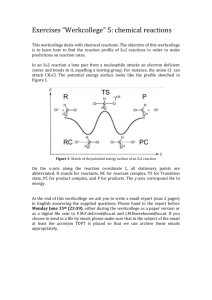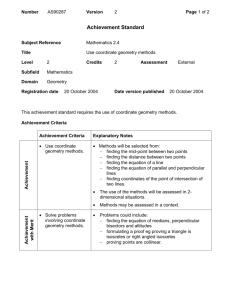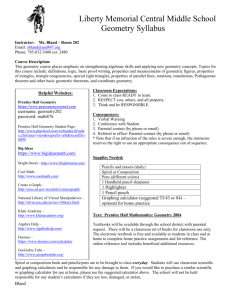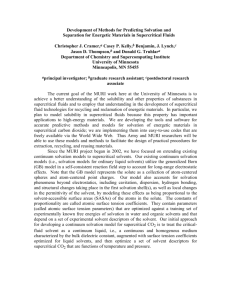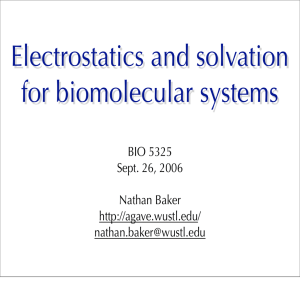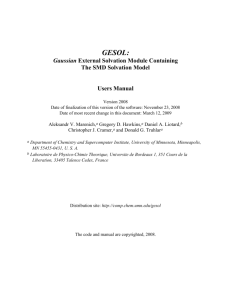Implicit solvation with COSMO
advertisement
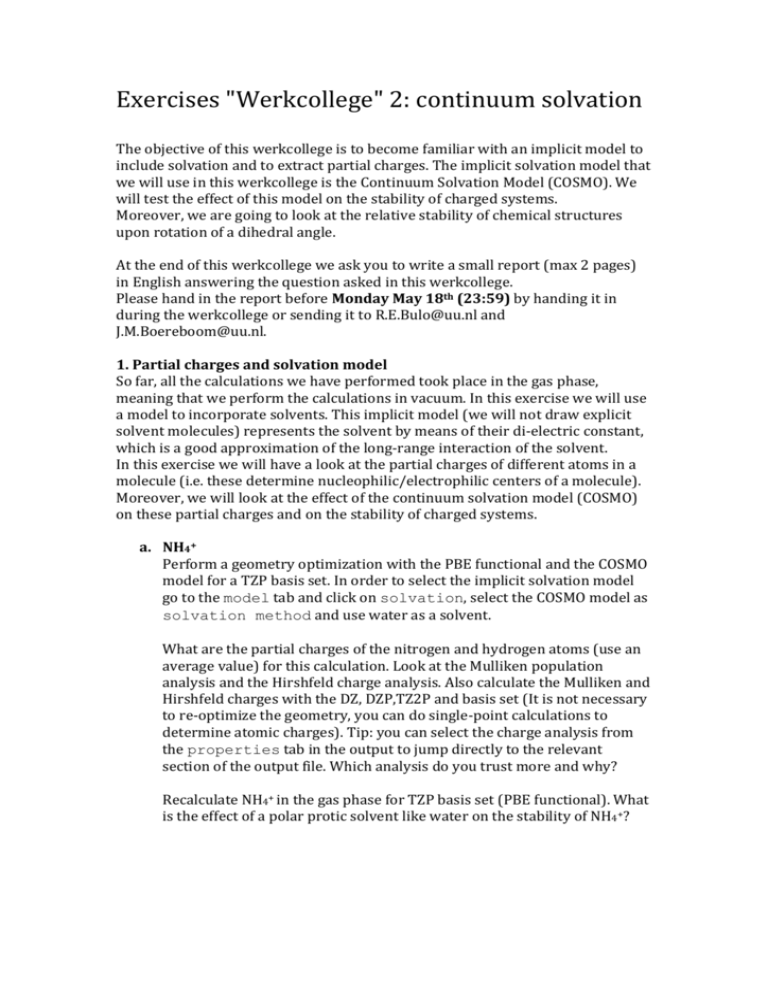
Exercises "Werkcollege" 2: continuum solvation The objective of this werkcollege is to become familiar with an implicit model to include solvation and to extract partial charges. The implicit solvation model that we will use in this werkcollege is the Continuum Solvation Model (COSMO). We will test the effect of this model on the stability of charged systems. Moreover, we are going to look at the relative stability of chemical structures upon rotation of a dihedral angle. At the end of this werkcollege we ask you to write a small report (max 2 pages) in English answering the question asked in this werkcollege. Please hand in the report before Monday May 18th (23:59) by handing it in during the werkcollege or sending it to R.E.Bulo@uu.nl and J.M.Boereboom@uu.nl. 1. Partial charges and solvation model So far, all the calculations we have performed took place in the gas phase, meaning that we perform the calculations in vacuum. In this exercise we will use a model to incorporate solvents. This implicit model (we will not draw explicit solvent molecules) represents the solvent by means of their di-electric constant, which is a good approximation of the long-range interaction of the solvent. In this exercise we will have a look at the partial charges of different atoms in a molecule (i.e. these determine nucleophilic/electrophilic centers of a molecule). Moreover, we will look at the effect of the continuum solvation model (COSMO) on these partial charges and on the stability of charged systems. a. NH4+ Perform a geometry optimization with the PBE functional and the COSMO model for a TZP basis set. In order to select the implicit solvation model go to the model tab and click on solvation, select the COSMO model as solvation method and use water as a solvent. What are the partial charges of the nitrogen and hydrogen atoms (use an average value) for this calculation. Look at the Mulliken population analysis and the Hirshfeld charge analysis. Also calculate the Mulliken and Hirshfeld charges with the DZ, DZP,TZ2P and basis set (It is not necessary to re-optimize the geometry, you can do single-point calculations to determine atomic charges). Tip: you can select the charge analysis from the properties tab in the output to jump directly to the relevant section of the output file. Which analysis do you trust more and why? Recalculate NH4+ in the gas phase for TZP basis set (PBE functional). What is the effect of a polar protic solvent like water on the stability of NH4+? b. Zwitterion: Diglycine Perform a geometry optimization of diglycine (see figure) in the gas phase with the LDA functional and a DZP basis set. Go to the details tab and click on geometry convergence. Set the Gradient convergence to 0.01 hartree/Angstrom and the Radial convergence to 0.05 Angstrom. We do this to reduce computational time. Please note that generally these settings are not sufficient to obtain reliable results, and should only be used as a last resort and if you know what you are doing (in this case it was tested that even with these settings, the outcome of the calculations is the desired outcome). In order to be able to calculate enough geometry iterations, it is needed (for ADF on Windows machines) to set number of geometry iterations to 100, this can also be done in the geometry convergence sub-menu. Have a look at the change of geometry during the geometry optimization with ADF View, what do you notice? Perform a geometry optimization of diglycine in water (with the COSMO model) selecting the same settings as for the gas phase calculation. Again, have a look at the change of geometry during optimization, what happens now? What does that mean for the stability of charged systems in polar protic solvents (like water)? 2. Rotational barrier of hexachloroethane To calculate the rotation barrier of a bond, we make use of a Linear Transit to scan the potential energy surface. Draw hexachloroethane and set a Cl-C-C-Cl dihedral angle to zero. Choose Linear Transit and then go to the model tab and select Geometry Constraints and Scan. Select the dihedral angle and set the first value to 0° and the last to 180°. Note that you will do the scan in 10 steps. You can use the LDA functional and a DZ basis set. Do not forget to set number of geometry iterations to 100. What is the most stable configuration? And what is the transition state? In order to obtain the energy of the different Linear Transit points it is best to search in the logfile for: Bond Bond Bond Bond Energy -1.04174499 a.u. Energy -28.34732363 eV Energy -653.70 kcal/mol Energy at LINEAR TRANSIT point: 10 = -1.041745 Then plot these energies with excel or a similar program of your liking. Replace the Chlorine atoms by other halogen atoms. What would you expect to happen with the barrier height? Compare the barrier heights of this calculation with that of hexachloroethane and comment on the findings. Please hand in the report before Monday May 18th (23:59) by handing it in during the werkcollege or sending it to R.E.Bulo@uu.nl and J.M.Boereboom@uu.nl.
